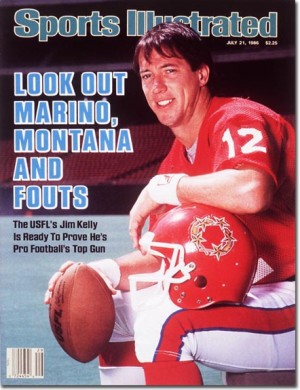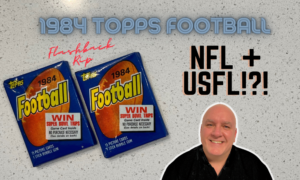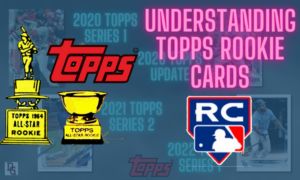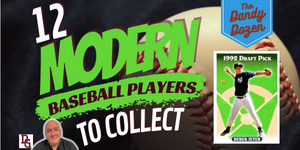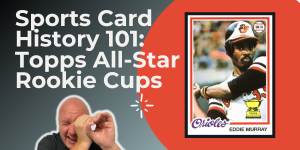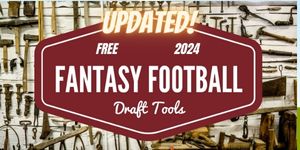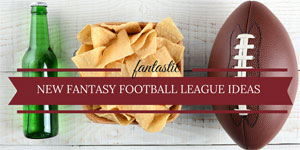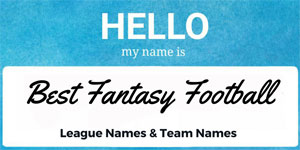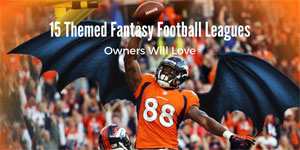This is part of a series of articles I’m writing that’s designed to inform people born in the ‘80s. I’m surrounded by people in their 20s and 30s, yet they are unfamiliar with a lot of great stories. My generation had to learn about the AFL and the ABA, and the current generation needs to know about the NFL’s rival league from the ‘80s, the USFL, and how it changed the game we watch today.
The USFL Impacted the NFL Greatly
Can you imagine a rival football league starting up these days, signing away star players out of college? In 1983, the league started playing games in the spring, which Fantasy Football owners wouldn’t mind these days also.
Three Heisman winners signed with the USFL, including RB Herschel Walker, QB Doug Flutie and RB Mike Rozier. But those are just three notable college players they got. In the end, the USFL employed four future NFL Hall of Fame players: DE Reggie White, Jim Kelly, Steve Young and Gary Zimmerman.
What if some rival league started up today and signed away recent college stars like Cam Newton, Trent Richardson, A.J. Green, Andrew Luck and, possibly the best Fantasy rookie QB ever, Robert Griffin III?
Future NFL head coaches like Jim Mora and Marv Levy also started in the USFL, and both saw success in the NFL using USFL stars (Kelly and Saints LB Sam Mills). Other future NFL head coaches and notable personalities include: Steve Spurrier, Lindy Infante, Jack Pardee and ESPN personality Lee Corso.
ESPN’s “30 For 30” did a really good job detailing how the USFL was created and later ended, with their documentary, “Small Potatoes: Who Killed the USFL?”
Famous USFL Faces
Jim Kelly: He threw for 44 touchdowns and over 5,000 yards as a rookie in 1984, and he eventually joined Levy in Buffalo to run the no-huddle attack that was nicknamed the K-Gun Offense. Kelly was one of the best Fantasy Football quarterbacks ever!
Dan Marino: And while the NFL owners were dumb enough to let QB Dan Marino drop to the 27th overall pick, whereas the USFL’s Los Angeles Express chose Marino with the league’s very first overall draft pick in 1983.
Steve Spurrier: The Heisman winner at Florida coached fellow former Gators QB John Reaves with the Orlando Renegades, where he would begin perfecting his Fun ‘n Gun Offense (known as “Bandit Ball” back then) that he would take to Duke, and then back to the University of Florida. He would win the 1996 National Championship with this team and the Fun ‘n Gun Offense, led by QB Danny Wuerffel.
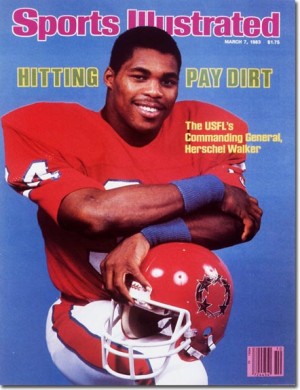 Herschel Walker: Since the USFL allowed juniors to leave college and play professional football, Walker left the Univ. of Georgia after winning the Heisman Trophy, and he chose to sign with USFL’s New Jersey Generals, which was bought by Donald Trump later in the year. Interestingly, Walker was quoted then as saying, “”I don’t know if I would want to play in the NFL unless it was for the two New York teams or the Dallas Cowboys.”
Herschel Walker: Since the USFL allowed juniors to leave college and play professional football, Walker left the Univ. of Georgia after winning the Heisman Trophy, and he chose to sign with USFL’s New Jersey Generals, which was bought by Donald Trump later in the year. Interestingly, Walker was quoted then as saying, “”I don’t know if I would want to play in the NFL unless it was for the two New York teams or the Dallas Cowboys.”
After winning two USFL rushing titles, the Cowboys drafted him in the fifth round of the 1985 NFL Draft, getting his NFL rights before the USFL folded. He joined RB Tony Dorsett in Dallas in 1986, playing fullback, and forming the first Heisman backfield tandem in NFL history. In 1989, he was traded to Minnesota in a trade that essentially helped the Cowboys to three Super Bowl titles in the ‘90s.
Reggie White: He signed with the Eagles after the USFL folded, and went on to become the NFL’s all-time sacks leader. He was also credited with being the first big-name free agent in NFL history, when he signed with Green Bay in 1993.
Doug Williams: Also, some high-profile NFL players left the league to join the USFL for more money. Players like QB Doug Williams and QB Brian Sipe gave the fledgling league a shot. Williams left Tampa Bay when they wouldn’t pay him a reasonable salary increase. Of course, he would return to the NFL in 1986, and help lead them to a Super Bowl win over the Broncos. He was the first black starting quarterback to win the Super Bowl, and he was named MVP.
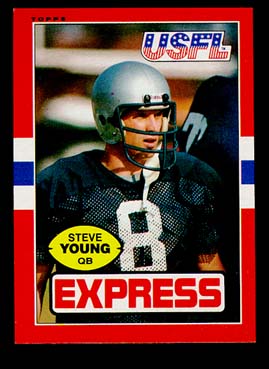 Steve Young: He was the first player chosen in the 1984 Supplemental Draft of USFL and CFL Players, by the Tampa Bay Buccaneers. He went 3-16 as a starter with the Bucs, and they would go on to trade him to the 49ers in the spring of 1987, just days before they chose Univ. of Miami QB Vinny Testaverde with the No. 1 overall pick. What’s really interesting about Young’s tenure in Tampa was the fact that Bo Jackson refused to sign with Tampa Bay after being the first overall pick in 1986. What if the Bucs were able to hold on to Young and Jackson, and they used their first-round pick in 1987 on a player like DE Jerome Brown, CB Rod Woodson, or LB Cornelius Bennett, who were all top-10 picks after Testaverde?
Steve Young: He was the first player chosen in the 1984 Supplemental Draft of USFL and CFL Players, by the Tampa Bay Buccaneers. He went 3-16 as a starter with the Bucs, and they would go on to trade him to the 49ers in the spring of 1987, just days before they chose Univ. of Miami QB Vinny Testaverde with the No. 1 overall pick. What’s really interesting about Young’s tenure in Tampa was the fact that Bo Jackson refused to sign with Tampa Bay after being the first overall pick in 1986. What if the Bucs were able to hold on to Young and Jackson, and they used their first-round pick in 1987 on a player like DE Jerome Brown, CB Rod Woodson, or LB Cornelius Bennett, who were all top-10 picks after Testaverde?
What-If 1985 Fantasy Football Mock Draft for USFL
- Herschel Walker, RB, New Jersey
- Jim Kelly, QB, Houston
- Tim Spencer, RB, Arizona
- Kelvin Bryant, RB, Phialdelphia
- Joe Cribbs, RB, Birmingham
- Chuck Fusina, QB, Philadelphia
- Gary Anderson, RB, Tampa Bay
- Richard Johnson, WR, Houston
- John Reaves, QB, Tampa Bay
- Maurice Carthon, RB, New Jersey
- Steve Young, QB, Los Angeles
- Ricky Sanders, WR, Houston
USFL’s Contributions to the NFL
Understand that this league many considered a step-child, much like the AFL, made several contributions to the game we watch today.
- The two-point conversion (although, this is also in college football).
- Challenging official’s rulings with instant replay.
- A salary cap.
- Arizona, Jacksonville, Tennessee and Baltimore now have NFL teams after they proved they could support pro football teams with the USFL.
- The Run ‘n Shoot offense.
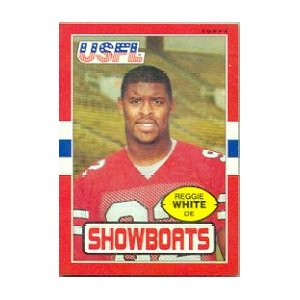 During the USFL’s lawsuit against the NFL for anti-trust, Raiders owner Al Davis exchanged his testimony against the NFL for not being part of the lawsuit. Donald Trump, one of the owners, hoped for a merger, but instead, the USFL won the lawsuit, but a jury awarded the league just $1.
During the USFL’s lawsuit against the NFL for anti-trust, Raiders owner Al Davis exchanged his testimony against the NFL for not being part of the lawsuit. Donald Trump, one of the owners, hoped for a merger, but instead, the USFL won the lawsuit, but a jury awarded the league just $1.
I’m always interested in old stories like this that just seem to be forgotten in today’s digital age. But the super-power that is the NFL today has both the AFL (before my time) and the USFL to thank. Heck, they even have the XFL (early 2000s) to thank for some other contributions, like the current overtime system in the NFL, and the skycam, which TV crews use to get a bird’s eye view of the playing field.
Even when the USFL was playing, I can’t say that there was a lot of interest in it – at least not from a 12-year-old boy in Central Florida, despite having the Tampa Bay Bandits and Orlando Renegades close by. But the impact from the league’s history certainly requires our respect and attention.

